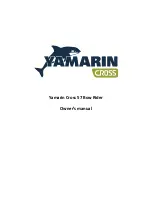
7
Uproar’s
SYSTEMS
The Engine-Starting/Stopping/Operating
Uproar is
powered by
a 4 HP Mercury 4 stroke outboard engine.
This is a great engine and if
cared for during your charter will serve you well. Always make sure the engine is getting coolant,
lubrication, and proper fuel by completing the checklist each day.
Pre-start Checklist:
ALWAYS check the following before starting the engine:
-
Engine is lowered into the water.
-
Fuel level is more than ½ full
-
Fuel tank vent is open
-
Connect fuel line
-
Ensure fuel petcock selector is in horizontal position (AUX tank) (see diagram)
-
Pump bulb
-
Kill cord connected
-
Engine in neutral (shift through forward, reverse, neutral)
-
Choke out
-
Throttle in
start
position keeps cold engine from running too high
(results in damage)
-
Make sure water is flowing out after start
Engine and Mount:
The outboard is secured on a motor mount that positions the engine aft of the rudder. To lower the
engine, rock the engine slightly forward and pull up on the stainless steel bail on the starboard side,
then allow the engine to gently tilt down. When in use, the throttle handle will contact the stern pulpit
unless it is raised above the level of the pulpit. At operating speed, the engine will generally remain
straight and the throttle handle can be raised to a vertical so that it does not contact the pulpit. To tilt
up the engine while sailing or at the dock, make sure the gear shift lever is in Forward and pull the
engine up to the horizontal position by grasping the handle on the aft end of the engine cover.
Starting the engine:
After completing the checklist, you are ready to start the outboard. Clear the boom, and crewmates
away from swing room as you will need clearance to get a good long pull on the start cord. With each
pull, try to get the maximum length of cord utilized by a quick snapping action at the last. Wait 3
seconds before next pull. It should start in 3-5 pulls. Once running, push in the choke until the engine
is running smoothly. To achieve full-throttle range the choke typically has to be completely pushed in
once the engine is warmed up.
If the engine doesn’t start
:
Go back through checklist to problem solve. Sometimes the fuel line is not fully attached, the kill switch
is not fully connected, or the vent is not open enough. Recheck everything, then retry.
Содержание J-80
Страница 1: ...1 J 80 Uproar Welcome Aboard Quick Start Guide Boat Manual ...
Страница 9: ...9 ...
Страница 11: ...11 Sails and Rigging ...
Страница 20: ...20 ...
Страница 23: ...23 Reefed Main Reefing Ties not too tight ...








































